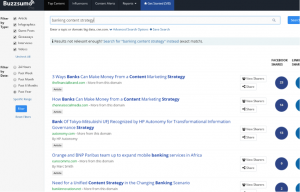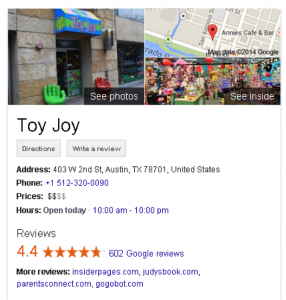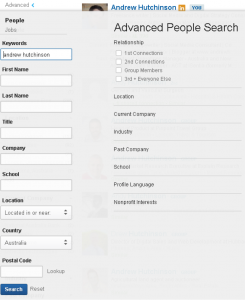So much has been made of big data for business – and rightly so, it’s a paradigm shift for traditional marketing and communications process. But less discussed are the benefits of social media and big data for individuals.
‘Thought leadership’ is the term we most often hear – how to utilise social to position yourself as an expert in your chosen field. But what about ways you can use big data and social media for the more basic aspects of introduction and interaction. Like, for example, getting a job? And of course, it can be used for just that purpose.
Here are five ways to utilise social and online data to better position yourself as the ideal candidate for any position.
1. Analyse the wording of the job ad
Everything online is about keywords and context. You might think job ads are less so, as they’re designed to locate candidates with specific skills, rather than have the job ad rank well in Google, but the key terms are still crucial, even in this context. How an advertiser words a job highlights the language they use internally, as well as the needs and possible pain points they’re looking for the right candidate to cover.
So let’s take a random job ad. Most of the time you’ll get a generic introduction paragraph about the company, then a basic description of the position title, then you’ll get into the needs of the role. We'll use an ad for a content marketing job in the banking sector.
‘The role is to help build, execute and manage content marketing strategies. The successful applicant will deliver best practice strategies that cover all content forms, including video, blogs and tool. The successful applicant will have a deep awareness of market trends, emerging technologies and innovations that can be leveraged to meet customer and business demand.
The position is responsible for growing traffic, engagement and sales by identifying opportunities through insight, analysis and stakeholder collaboration. The successful applicant will think and deliver content stories, and will be able to deliver high quality storytelling that delivers the right content in the right format to the right channels, in alignment with best sales and servicing opportunities. The position will work closely with business stakeholders including Marketing, Product, and CX to understand business drivers, help articulate them as customer opportunities and develop strategies that will support business goals. They are responsible for communicating and managing stakeholder buy-in for strategies proposed.’
From this, we need to identify the main keywords of focus in the description, as these terms are likely to be considered highly relevant by the company, particularly in relation to this role. One way of doing this is to create a word cloud of the ad text to see which terms are mentioned the most – you can do this via Wordle: 
From this, we can ascertain that the following keywords are of high relevance to this role:
– Content
– Strategies
– Business
– Stakeholder
Using this info, we can re-check the specific words against the description to see if we can qualify them even further with related terms:
– Content Strategy
– Content Marketing Strategy
– Stakeholder Buy-In
– Content Marketing Opportunities
This provides a good guideline as to what elements of the role you’ll need to be across; the crucial skills the company requires from this position. While the keywords identified in this example are the ones you’d probably have gleaned from a basic read-through, the word-cloud can highlight important areas of focus – an account position might focus on ‘compliance’, for example, a management job on ‘change’. The more text in the job ad, the better, as it will uncover the employer’s key points of focus for the role.
These are also the terms you want to highlight on your own LinkedIn profile, résumé, and any other social media properties that you’re using to build your professional profile. A good way to test this is to enter your own LinkedIn profile or résumé text into Wordle too and see what terms are most prominent and how they match up – if they don’t, might be worth reviewing your wording to see if you can update to match the relevant terms.
2. Research the key terms and how they’re being used in relation to the company and industry
Once you have your key terms, you can research these specific areas to ensure you’re across the latest industry discussion.
In this example, we know the key terms are ‘bank’ or ‘banking’, as it’s in the banking sector, and the four noted terms from our Wordle research. A good way to research the latest discussion on a topic is to enter them into BuzzSumo. BuzzSumo is a content discovery tool that allows you to search for the most shared content across social platforms, by topic, keyword, or URL. In this case, we’d conduct a search for ‘banking content strategy’ to start with:
This will show you the most shared content using those keywords. Now you know the most discussed industry posts, enabling you to quickly get up to speed with the big news and advances specific to the industry and position. It’s worth reading through as many of these as you can to ensure you’re across the latest info.
What you can also do in BuzzSumo is you can search the company’s URL to see the most shared content they’ve created. This is great insight as it will highlight where they’ve seen the most success with their content, the things that have resonated with their audience. This gives you a solid basis for discussion, as you will know what they’ve focussed on, what people have responded to, and it’ll give you an idea of their key areas of focus. You can also enter the company name into BuzzSumo and it will show you the most shared articles mentioning them, which can be particularly helpful for bigger brands.
3. Get to know the company via their social presence and content
While companies are benefitting from users sharing more and more of their information online, brands too are posting more of their information on social platforms, making it a great research resource for job seekers.
First, you need to go to their website and check if they have any social media links, normally on their main page or in their contact info. The sites they link to from their homepage will most likely be their main social platforms of focus, and locating them this way also saves you from conducting your own search for their brand profiles on each platform and potentially linking through to fake or fan pages not affiliated with the actual brand.
You should open each of their social profiles and take a look around – what content are they posting about? How often do they post? What sort of engagement are they seeing? What they’re posting on social media can reveal a lot about the company’s interests and how it wants to portray itself.
Take note of any award announcements, milestones, the way they’re engaging with fans/followers – all these details will help give you a better picture of how this brand does business, what they’re looking for culturally, whilst also giving you notes on talking points you can use to show you’ve done your research and that you’re enthusiastic about the role.
Here’s another cool research tip (though not in wide use as yet) – in 2010, Google added ‘Google Business View’ to Google Maps. Google Business View gives users an inside look at businesses that have registered for the program, complete with a walkthrough inside their premises. When you conduct a search for the business name (and relevant location), look out for the ‘See Inside’ option in the thumbnails on the Google search feature match, over on the right hand side of the results:
Now you can do a full office tour before you even set foot inside the building. When they offer you a water, tell ‘em you can get it yourself (note: don’t actually do this).
4. Look at the types of people they’ve already employed
LinkedIn gives you access to such a huge amount of data in this regard, more than most people might realise or even consider.
A recent discussion noted that as data depth on LinkedIn continues to grow, there may come a time where we’ll have a system that can accurately suggest a person’s ideal career path, based on their attributes and interests. That’s how much data LinkedIn has access to – the suggestion of assigning roles most likely to provide each individual with optimum job satisfaction, based on their interests and attributes, is no longer some crazy scheme confined to the realms of science fiction.
For the purposes of job search, one way to use LinkedIn’s data is to search for employees of the company you’re hoping to join. Using the advanced search functions, you can narrow down your search to job title and location.
From this, you can get a full overview of all the people you’d likely be working with, their career experience, their interests, etc. This info can give you great insight to the people the company employs and where you might fit (you may or may not want to switch your LinkedIn settings so you don’t show up as viewing all these people’s profiles, up to you on that front). It’s also advantageous if you know who’s going be conducting your job interview – checking out their LinkedIn and other social media properties can give you a sense of who they are, what they’re interested in, and how you can connect.
Facebook’s Graph Search is also good for this – a search for ‘Pages liked by (insert name)’ will give you an oversight into the things that person is interested in and what they do in their spare time. You might think that’s a bit creepy, or that it could come off as creepy, which it definitely can if not done right (‘oh hey, you’ve got a couple of kids, right? Yeah, I saw some pictures of them, they’re cute’), but there can be significant value in paying attention to the details.
I read a post recently on LinkedIn where the author, Bronwyn Cook, switched telco providers based, in part, on her new provider paying attention to her Twitter bio, in which she professed her love for Bon Jovi. The new provider noted this and used it as a theme in their initial interactions, opening the door for further discussion and, subsequently, gaining them gaining a new client.
5. Ensure your LinkedIn profile (and any other public profile) reflects the skills relevant to the position
As noted in the first point, it’s important that your social media profiles reflect the same keywords and focus of the roles you’re applying for. Outside of LinkedIn, it’s also worth sharing industry content via your social channels – even some of the content you find in your BuzzSumo research – in order to underline your interest and expertise in the field.
Anyone seriously considering you for a position is going to Google you and check out your social presence, so it’s worth reviewing what they’re likely to find and ensuring it matches up with the key attributes you want to highlight. Sharing a heap of content a couple of days before going in for an interview probably isn’t the best the way to go – it’s pretty easy for them to scroll down and see that you’re not normally as active – but consistently sharing content over time highlights that you’re reading industry content, that you’re staying on top of what’s happening. In this context, it’s more than just being a resource for your connections and followers, it’s about showing you’re passionate about the subjects relevant to your future career.
It’s always important to do your research before a job interview – it shows diligence, professionalism and that you have an understanding of, or interest in, the industry. But now, with so much company data available at your fingertips, it’s more important than ever to read up. Worth noting that everyone else can access the same information you can, everyone has opportunity to do the same research. The best way to stand out is to be smarter about how you go about it, more analytical in finding the things that are relevant to you and your prospective position. What can you do to help the company? Where do you see your skills being of benefit?
The more you know about the business, the more you’ll see how you might fit, what details strike you. If you’re able to express those details in an interview situation, and they resonate with the people conducting the discussion, you may just find your perfect career fit, and a position you can happily stay in for some time.
Latest.

AI adoption failing isn’t the tech, it’s the people. How smart businesses overcome this.
Technology, Thought Leadership, Industry Trends

Temp-to-perm is the best way to hire today.
Hiring Insights

How to keep top talent: Strategies for successful onboarding
Hiring Insights, Ask Aquent, Training Resources






